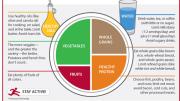Read Jonathan Shaw’s article on the connection between red meat consumption and diabetes risk in the January-February issue of Harvard Magazine, then explore Harvard’s new Healthy Eating Plate (above). Created by nutrition experts at Harvard School of Public Health, the new eating guideline was unveiled months ago in response to the United States Department of Agriculture’s (USDA) replacement for the food pyramid, My Plate, symbolized by a plate with four sections—fruits, vegetables, grains and proteins—with an attached glass of milk that the agency says should all be part of a “healthy, balanced diet.”
While Harvard's plate also has the same four sections, it offers more detailed information on what foods to eat, and which ones to avoid. For example, in place of the grains section, the Healthy Eating Plate includes a whole grains section. Other differences include an explanation of what proteins are healthy—poultry, fish, beans and nuts—emphasizing the need for healthy fats, such as the heart-healthy omega-3 fatty acids in fish, and the fiber in beans. Harvard's plate also replaces milk with water and recommends only one to two servings a day of low-fat milk, since high intake levels are associated with increased risk of prostate cancer and possibly ovarian cancer.
For more detailed information on the two eating guidelines, explore this side by side comparison on the Harvard School of Public Health’s website.









